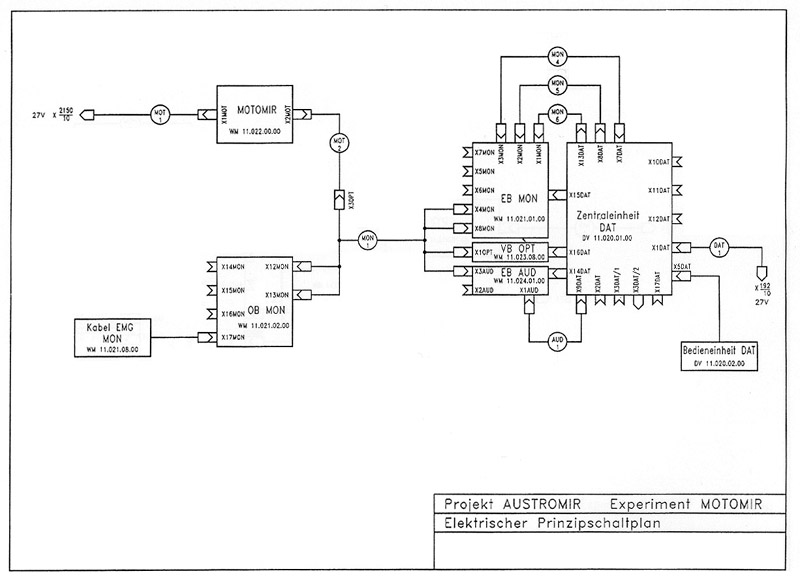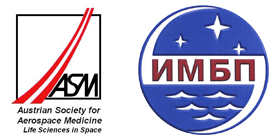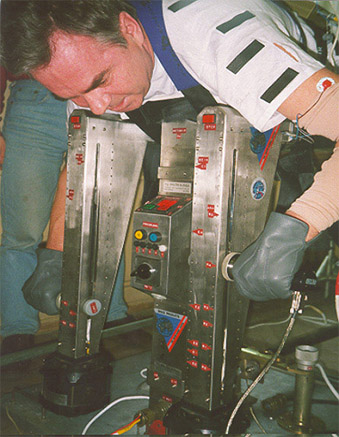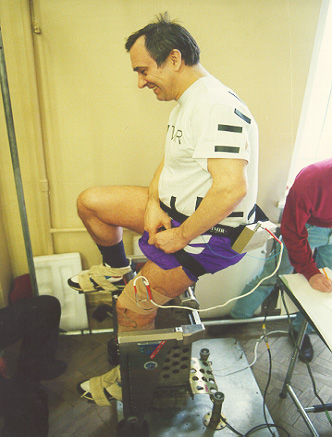On Earth, man lives from birth under the conditions of terrestrial gravity. The cessation of this essential environmental factor effects changes in nearly all systems of man’s organism. Due to the functional burden of the musculature during space flights, a cell structure conditioned degeneration in the form of a decrease of the muscle mass, the muscle fibre profile, the realizable strength and even their endurance capability are affected. Most of these changes found during and after space flights are quite comparable with such adaptations that one finds on athletes and normal persons in phases of inactivity or immobilization. This fact turns up quite interesting awareness of space flight physiology and even for many other medical categories, for example preventive and rehabilitative medicine, intensive medicine, geriatric medicine and up to sport medicine. Space flight medicine enables a unique way of investigating degradation speeds and the degree of catabolic processes of muscular and bone substance, as well as the cardiovascular performance decline and functional changes in nearly complete body weight relief, and to develop strategies to work against these de-adaptive changes.
The dynamometer „MOTOMIR“, developed within the framework of the Austrian-Russian “AUSTROMIR-91” project, was used to document for the first time a degradation of muscle strength at different periods during a long-term flight within the “MYO-MOTOSCAN” experiment. Conclusions about the efficiency of training provisions executed onboard the MIR space station could therewith be achieved. This is therefore especially important because a decrease of capability increases the risk that complex tasks of a space mission are not carried out as required and could jeopardize the life of other team members.
Objectives
A question was raised at the beginning of the space age: whether a manned space flight is at all possible. So today a question is raised: what should be done in order for spacemen to return back to Earth healthy and capable again after a long-term sojourn? In this regard, the following four research targets arose for the MYO-MOTOSCAN project within the RLF project:
- Non-invasive diagnosis of the maximum strength and strength duration capability of different muscle groups during and after a long-term sojourn is space, and therewith a determination of the cosmonauts’ actual performance state and components of the performance state before, during and after the space flight.
- Research on the impact of the influence of micro-gravitation on different muscular action forms (isometric, concentric, and eccentric).
- Quantification of the time elapsed and the degree of de-adaptive changes of the muscle strength during a long-term flight.
- Examination of the influence of strength training with the dynamometer Motomir for decrease and prevention of muscular deficits in the upper and lower extremities during a long-term flight.
Functionality, Measuring principle
The MOTOMIR dynamometer is a computer-controlled device operated by two electro motors. It enables the diagnosis and training of muscular strength in space. The speed is kept technically constant through selected movement amplitude (encoder) during concentric and eccentric tasks. The actors on which the cosmonaut exerts force with the feet or hands fixed in a defined pivotal angle (isometric) are also kept constant. The force exerted on the actors is recorded with the help of an extensive measurement film bridge and is forwarded synchronously with EMG data from the four muscles through the MONIMIR box for saving in DATAMIR. The device is electronically calibrated before each test, as well as executing gravitation adjustment.
The test assignments are supplied to the cosmonaut with the help of a laptop. The test cycle (12 programs) including strain and recovery times is kept constant before, during and after the flight in order to enable comparability.
The weight of the MOTOMIR flight model including saddle, manufactured from titanium, was 47.2 kg, having dimensions of 1210 mm x 626 mm x 470 mm. The movement amplitude of the actors was a maximum of 450 mm, the actors’ speed could be chosen from within a range of 0 and 600 mm/sec. Motor: brushless DC motor designed for onboard electric supply of 23-25 Volts.
Shared equipments of the Austrian payload
DATAMIR, MONIMIR
Results
Results of 8 cosmonauts (2 Main Team 10 and 11, and 6 Main Team 15-16 = RLF) were won before, during (at various periods up to 14 investigations), and 4 and 6 days after the flight of long-term missions. These results were evaluated with special analysis software (NOVA AEROSPACE).
Synopsis of the results:
- Rash significant strength degradation in microgravity affects those muscles that work against gravity under terrestrial conditions. The strength decrease of the leg stretching musculature after a sojourn of one month was an average of 43.0% and that of leg bending musculature was 30.2%.
- On the other hand, the strength decrease of the arms is clearly lower pronounced and is an average of 10% for the extensors and flexors.
- The strength decrease of the lower as well as the upper extremities in all muscular action forms (isometric, concentric, eccentric) is similarly strongly pronounced.
- The organism has extensively adapted to its new physical environment after a period of 3-4 weeks. A new strength level (new homeostasis) developed.
- Although the strength decrease was nearly similarly strongly pronounced for all cosmonauts after a period of 3-4 weeks, clear inter-personal differences were shown in the remaining duration of a long-term flight. This can be traced back to training provisions (exercise countermeasures) carried out differently.
- With a training study of a long-term cosmonaut (175 days – single case study), it could be shown for the first time that a muscular de-conditioning can be avoided even during a long-term space flight if corresponding high strength training stimuli are set frequently.
- During his world record flight of 437 days, Valerij Polyakov could show that it is possible to keep strength loss within maintainable limits with consequent execution of corresponding training provisions.
Technical characteristics
The equipment MOTOMIR consisted of the following units

Ergometer MOTOMIR including the Equipement and reserve parts
- Ergometer MOTOMIR
- Cable MOT1
- Cable MOT2
- Breast backing for armwork
- Shoes with fixation for footwork
- Mechanical interface MOTOMIR – MIR
- Universal keys
- Transport casing
| Mass: | 47.2 kg |
| Dimensions: | 1210 mm x 626 mm x 470 mm |
| Power input: | max. 760 W 2200 W Impulse max. value |
Experimenters
Medicine:
Univ.-Prof. Dr. Norbert Bachl (project manager)
Univ.-Ass. Univ.-Prof. Mag. Dr. Harald Tschan
Univ.-Prof. Dr. Ramon Baron
all: Centre for Sport Sciences and University Sport, debt. Sport- and Earned Physiology, University of Vienna
Technics:
Dr. Harald Stockhammer (project manager, Software)
all: FDP, Company Fanak Data Processing Ges.m.b.H., Vienna
Dipl.-Ing. Dr. Massud Mossaheb
all: Company NOVA AEROSPACE
Sub-contractor:
Ing. Walter Bumba (Hardware)
Werner Weihs-Sedivy, MSc
Ing. Christian Wieland
Ing. Michael Smutka
Ing. Werner Fuchs
all: Company Ing. Walter Bumba, Vienna
Prof. Dr. Inessa Benediktina Koslovskaja
Dr. N. M. Kharitonov
Dr. Yu. Koryak
all: IMBP (Institute for Biomedical Problems), Moscow


